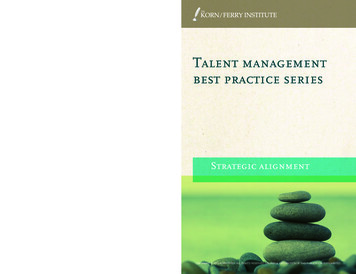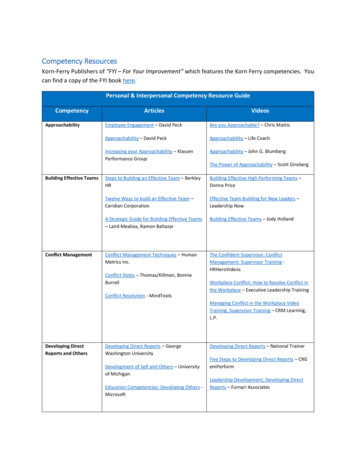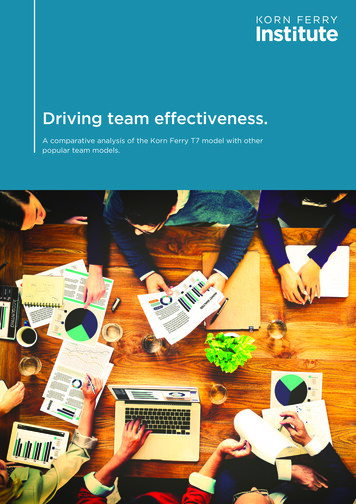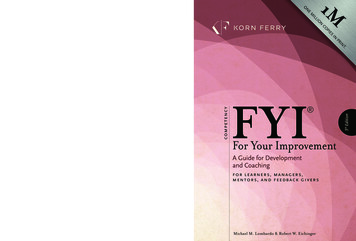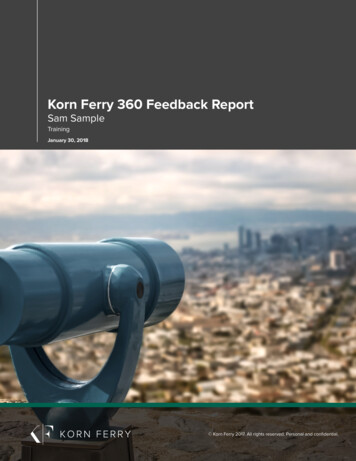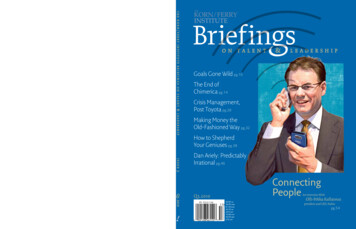
Transcription
the korn/ferry institute briefings on talent & leadershipGoals Gone Wild pg.10The End ofChimerica pg.14Crisis Management,Post Toyota pg.26Making Money theOld-Fashioned Way pg.32How to ShepherdYour Geniuses pg.38issue 3Dan Ariely: PredictablyIrrational pg.46Q3. 2010ConnectingPeople Olli-Pekka KallasvuoAn Interview WithQ3.2010 9.95 us 9.95 cnd 7.50 eur 6.70 uk 915 jpy10.60 chf36.50 aed 70 cnypresident and CEO, Nokiapg.54,
Chief executive officer Gary BurnisonChief marketing officer Michael DistefanoEditor-in-chief Joel KurtzmanPublisher Laurance Allenmanaging editor, online Derek Fromsoncreative Director Joannah Ralstoncirculation director Peter Pearsallmarketing coordinator Stacy LevynBoard of Advisors Sergio AverbachStephen Bruyant-LangerCheryl BuxtonDennis CareyAna Dutracontributing editors Chris BergonziLawrence M. FisherVictoria GriffithSakie FukushimaJoe GriesedieckRobert HallaganLan KangJohn KellerRobert McNabbAlice PunchGary ReidyAnthony VardyDan GuglerPaul HempStephanie MitchellDeborah J. JacobsGlenn RifkinThe Korn/Ferry International Briefings on Talent and Leadership is publishedquarterly by the Korn/Ferry Institute. The Korn/Ferry Institute was founded to serveas a premier global voice on a range of talent management and leadership issues. TheInstitute commissions, originates and publishes groundbreaking research utilizing Korn/Ferry’s unparalleled expertise in executive recruitment and talent development combinedwith its preeminent behavioral research library. The Institute is dedicated to improvingthe state of global human capital for businesses of all sizes around the world.ISSN 1949-8365Copyright 2010, Korn/Ferry InternationalCover illustration:Masao YamazakiPEFC CertifiedThis product isfrom sustainablymanaged forests andcontrolled sourcesPEFC/US09000236Requests for additional copies should be sent directly to:Briefings MagazinePO Box 327Derry, NH 03038-0327Circulation customer service phone: 603-965-2232This is a Skype number with worldwide service.For reprints, contact Laurance Allen at 508-888-0050www.pefc.orgPrinted in the USA
contents1014205 Letter from the CEOSuccession8 Launch Party20 h ow michael mondavi took chargeLatest ThinkingTo put his plan in place, Michael Mondavi had to leavethe family businessBY lawrence m. fisher10 g oals gone wild Problems happen when you have too many goals.Governance12 y ou get what you pay for The good news — incentives still work.26 c risis management, post toyota o manage in a firestorm, you need a plan but youT14 t he end of chimerica Differences between China and Americamay be difficult to bridge.Viewpoint16 the mystery of leadershipTo understand leadership, you have to do it.BY stephen joel trachtenbergneed flexibility, too.BY victoria griffithTalent32 making moneythe old-fashioned wayBuying good companies is no longer enough.BY david snow38 h ow to shepherd your geniuses o be innovative, you have to let the best brains rule.TBY paul hemp
3246263854DowntimeEurope in Perspective4562 t he price of double standards he problems are in Greece, but the opportunitiesT Wit and wisdom from the front lines.Profile46 d an ariely: predictably irrational hen you explore human nature, you might not findWwhat you expect.BY glenn rifkinThe Big Picture52 The world is changing. Here’s how.Interview54 connecting peopleOlli-Pekka Kallasvuo is passionateabout his task.by gary burnisonare in Turkey.BY adrian wooldridgeIn Review66 “ clever”68 “rethinking the mba”Parting Thoughts72 t he medium is still the messagePay attention to how social media changespeople’s minds.BY joel kurtzman38
fromthe ceothe good ole daysStimulus ending. Unemployment lingering.Deficits growing. Interest rates rising.Taxes increasing. Corporate growth unclear.Welcome to the new normal. In the West, that is.Recently, my son and I were pulling into ourdriveway when he asked, “Dad, do you remember thegood ole days?” I was amazed at his question. Whydid he ask me that? My mind immediately raced tomy own father years ago talking to his World War IIera sisters about “the good ole days.” Was that whatmy son meant?Historically, the good ole days mean, at least inpart, the long progression of Western nations fromtheir rural agrarian roots to manufacturing powerhouses and then into the technological era. For corporations, the good ole days meant steady and sustainedgrowth as their factories and plants satisfied theneeds of the world. The good ole days seem to haveended before Wall Street’s financial wizards tookhome an Oscar for the runaway box office hit “TheGreat Credit Debacle.”Today, the white-knuckle free fall is over, but theeconomic revival is tentative, and the engines ofgrowth are not as apparent as they were in the goodole days. Some business leaders and strategists willlook to the East while others will push to innovate,and still others will merge and acquire to grow andexpand market share.Almost every CEO and business leader thinks incessantly about growth, and this will be especiallytrue over the next 12 to 24 months. They will do thisbecause the sky is still partly cloudy and during timeslike these, companies have a bias toward liquidity.But, as great as the growth challenge is today, theleadership challenge over the next two years will beeven greater, and leaders will have to provide certaintyto employees in an uncertain economic climate. Theywill have to do this because the great credit debacleBriefings on Talent & Leadershiphas taken its toll not only on the Cityof London and Wall Street, but also onMain Street companies and, most importantly, their employees. Most ofthese employees probably know someone who is out of work, has been furloughed, has had his or her benefitsslashed, or is working less than fulltime. Grateful to have jobs, they are probably workingharder for less pay. Keeping a work force moving forward will be an enormous challenge in the weeks andmonths ahead.Leaders, therefore, must find a way to move people ahead with hope, courage and a vision of what ispossible. Maybe now, more than ever, an organization needs to be anchored with a common purpose.As Eli Broad, founder of two Fortune 500 companies,number 42 on Forbes’s list of billionaires and, mostinterestingly, a global champion of philanthropy, recently told me, “The CEO must define the mission,whether it’s a business, nonprofit or government.”And, CEOs have to do so in a way that makes employees believe the goal is achievable. “Part of the jobof a leader is to convince them it’s achievable, toget people to do more than they thought they coulddo,” Broad said. No matter how troubling or murkythe times may be, leaders must rise above it all andinspire.Yet vision alone will not do the job. Companieswill need to innovate. How does that happen? In thisquarter’s issue of The Korn/Ferry Institute’s Briefings onTalent & Leadership, you will find an interview withLinda A. Hill, a professor at Harvard Business Schooland faculty chair of its Leadership Initiative, whoQ3.20105
6Q3.2010study economics and human behavior. Ariely recounts that he once secretly placed several six-packsof Coca-Cola in refrigerators in the communal areasof an MIT dormitory as part of an experiment andthat all of the Coke was gone within 72 hours. Then,when he placed plates with six one-dollar bills on eachof them in the same refrigerators, not a single dollarwas taken. Ariely concluded that people are comfortable cheating or stealing if what they are stealing isone step removed from cash. Perhaps the great creditdebacle has less to do with executive compensationplans and more to do with human behavior.Finally, “How Michael Mondavi Took Charge”profiles R. Michael Mondavi, son of the noted California wine pioneer, Robert Mondavi. After being forcedout of the family wine business, Michael did not cryover sour grapes. He recalls being told, “No, Michael,it’s not a tragedy. A tragedy was when Napoleon triedto conquer Italy; World War I, World War II. This isnot a tragedy; this is just a difficult time.” So Michaeltook a difficult time in his life and turned it into anopportunity by creating a new global firm with an innovative business model and an Italian winery as hispartner.I hope you enjoy this issue of Briefings and find itfood for thought. Our aim is not just to make you think,but also to help you decide what to think about. Although growth may not be readily apparent at the beginning of this decade, change will envelop us and innovation will free us. When my grandson asks aboutthe good ole days, I will tell him of a time when leadership mattered, which it does, now more than ever. —Gary Burnison, chief executive,Korn/Ferry InternationalSuperStockexplores how great leaders do not necessarily set thedirection but rather create the context for innovation.In “How to Shepherd Your Geniuses,” Hill refers to Nelson Mandela, who was certainly a social innovator ofthe highest order. According to Mandela, his tribe usedto say that “a leader is like a shepherd. He stays behindthe flock, letting the most nimble go out ahead, whereupon the others follow, not realizing that all along theyare being directed from behind.”In this issue of Briefings, we also interview the innovator Olli-Pekka Kallasvuo, Nokia’s chief executive.A rare combination of passionate leader and humbleman, Kallasvuo has been instrumental in Nokia’s transformation from an industrial company to a global hightech leader.Authentic leadership complements innovativeleadership. Authenticity can come into play, for example, when a leader responds to a disaster. In “CrisisManagement, Post Toyota,” Victoria Griffith discussesToyota as a case study in how executives should notrespond to a crisis. And, she explodes myths, suchas “The best advice in a crisis comes from the legaldepartment.” In today’s world, it is not easy to keep asecret, so it is best not to try, she argues.Science is also a factor in leadership and management styles. Dan Ariely, a cognitive scientist with labsat the Massachusetts Institute of Technology and DukeUniversity, is profiled in “Predictably Irrational.” Whenhe was 18 years old, an explosion left him severelyburned over 70 percent of his body. That was followedby an agonizing three-year hospital stay and countless surgeries. This experience changed his life, and itcaused him to wonder why people do what they do.His path of inquiry led him to use cognitive science toThe Korn/Ferry Institute
LAUNCH p a r t yOn March 10, 2010, Korn/Ferrycelebrated the launch of Briefings andthe release of our Editor-in-Chief’s25th book entitled “Common Purpose”at Michael’s Restaurant in New YorkCity. Over 120 notable guests enjoyed2an evening of good conversation andspirited and insightful comments onleadership.138Q3.2010CreditLeft to right: Michael Distefano, Chief Marketing Officer,Korn/Ferry International; Joel Kurtzman, Editor-in Chief, Briefings;Laurance Allen, Publisher, Briefings4The Korn/Ferry Institute
5 81. Joel Kurtzman, Editor-in-Chief,Briefings; Joseph Rice III, Chairman,Clayton Dubilier & Rice2. Patricia O’Connell, ManagementEditor, Bloomberg BusinessWeek3. Aron Duta, Office of the Chairman,Cisco Systems4. Bob Damon, President North America;Caren Fleit, Senior Client Partner,Korn/Ferry International5. Richard Dresdale, (center)co-founder, Fenway Partners966. Judith Roland, President, RolandCommunications; Rocco Maggiotto,Senior Executive Advisor, Zurich Financial7. Elizabeth Tuggle, (center) Reporter,Fox Business News8. Georgette Mosbacher, President and CEO,Borghese; Nels Olson, ManagingDirector, Korn/Ferry International9. Charles King, Managing Director,Head of the Americas, Korn/FerryInternational; Dave Anderson, Sr. VicePresident & CFO, Honeywell Inc.10. Andrea Soriani, Director of BrandMarketing & Events, Maserati;Leila Zogby, Journalist11. Matthew Budman, Editor-in-Chief,The Conference Board ReviewCredit12. Joe Griesedieck, Vice Chairman,Korn/Ferry InternationalBriefings on Talent & LeadershipQ3.201079
Latestthinkinggoals gone wildIt turns out that having goal-oriented employees might not be the best thing for employers.Modern management has gone overboard with some popular concepts, leading to some counterproductive results. Consider how the concepts of management-by-objective and goal setting, firstpopularized by Peter Drucker more than 50 years ago, play out in today’s organizations. Managers — especially human resources managers — have become increasingly obsessed with deconstructing each employee’s expected contribution into a detailed list of measurable milestones.The point of the exercise is ostensibly to provide motivation, but often the result is a paint-bynumber work force whose performance may be on target but not what is most needed.The U.S. is the only one of22 countries ranked highestin economic and humandevelopment that fails toguarantee long-term paid sickleave, and one of only threecountries — Canada and Japanare the others — without anational policy requiringemployers to provide shortterm paid sick days.Source: Center for Economic and PolicyResearch, 200910Q3.2010As with any powerful drug, the help it provides depends on the dosage.When Goals Are Too SpecificSpecific goals can be so narrowly focused thatthey blind people to other factors and concerns that may be equally or more important,the authors say. Precisely defined goals discourage people from looking at a problemfrom a variety of perspectives and foster amind-set in which merely hitting one’smarks is good enough.The authors cite many examples of this,including Ford Motor Company’s attempt inthe late 1960’s to compete in the small, fuelefficient car market. In response to the challenging goals of bringing a fuel-efficient,modestly priced car to market quickly, theFord Pinto was developed, but at the expenseof other important considerations that werenot specified as goals, such as safety, ethicalbehavior and company reputation. In fact, afaulty design in the placement of the fueltank and omitted safety checks resulted inPintos igniting on impact and a multitude oflawsuits. Even after discovering the hazards,executives did not correct the design, calculating that doing so would have cost morethan the lawsuits that were likely to be filed.Goal setting can also inhibit characteris-Hal MayforthTHE WALKING WOUNDED:COMING TO A COUNTRYNEAR YOUFor years, studies and practitioners havegenerally concluded that specific, challenginggoals motivate employees, focus their effortsand provide clear, objective means for evaluating their performance. However, in their2009 paper, “Goals Gone Wild: The SystematicSide Effects of Over-Prescribing Goal Setting,”four noted professors of management question that view. They present an impressive review of research and a wealth of examples toargue that while goal setting can improve performance, it can also degrade it by overly narrowing focus, weakening interpersonal relationships, corroding organizational cultureand increasing risky and unethical behavior.“For decades, goal setting has been promoted as a halcyon pill,” write Lisa D. Ordóñez,a professor at the Eller College of Management of the University of Arizona; Maurice E.Schweitzer, associate professor of operationsand information management at the Wharton School of the University of Pennsylvania;Adam D. Galinsky, professor of ethics and decision in management at the KelloggSchool of Management at NorthwesternUniversity; and Max H. Bazerman, professor of business administration at Harvard Business School. “We contend, however, that it has been over-prescribed andit has powerful and predictable side effects.”The Korn/Ferry Institute
tics in employees that are essential in today’sorganizations — a willingness to learn andadaptability. Because the act of setting specific goals assumes that optimal outcomes areknown beforehand, it discourages opennessto alternative outcomes, exploration andgrowth. The resulting inflexibility can sabotage collaboration, an essential aspects oforganizational behavior.When Goals Are Too ChallengingThe Judicious Use of GoalsHow, then, do the authors suggest goal setting should be used? They say that a crucialfirst step for managers is to think carefullyabout whether specific goals are necessary.Most managers “think that others need to bemotivated by specific, challenging goals farmore often than they actually do,” the authors say. They cite studies showing that although goal setting does increase extrinsicmotivation, it can undercut intrinsic motivation — engaging in a task for its own sake —so that the net effect is usually negative.Consequently, the authors recommendthat if goal setting is to be used, the goalsshould be as comprehensive as possible andtake into account all the critical componentsof an organization’s success, both quantitative and qualitative. It is also critical thatshort-term goals do not conflict with desirable long-term outcomes and that acceptablelevels of risk and ethical guidelines are clearlyand explicitly articulated. To reinforce collaboration and cooperation, team goals shouldreplace individual goals when practical.Perhaps most importantly, the authorssay that in complex, changing environments— that is to say, all organizations — what theycall “learning goals” are likely to be more effective than performance goals. That means,essentially, that goal setting should be lessabout achieving specific outcomes and moreabout optimizing the enterprise. Everett Peck“Goals Gone Wild” cites studies showing thatpeople given highly challenging goals aremore likely to adopt inappropriately riskystrategies to try to achieve them than if thegoals are more modest. There is also substantial evidence that goal setting of any kind caninduce unethical behavior, such as that displayed by Sears Brands mechanics who recommended unneeded repairs in an effort tomeet their quotas and by Bausch & Lombsales representatives who “met” their targetsby reporting sales that never took place.The authors write that a healthy organizational culture is probably the best insurance against these kinds of harmful effects,but they point out that the use of goals candamage an organization’s culture. On balance,they say, “the use of goal setting creates a focus on ends rather than means, and aggressive goal setting within an organization willfoster a climate ripe for unethical behavior.”Another problem arising from the use ofso-called “stretch” goals is the possibility thatthe goals may not be reached. This can causepeople to unduly question their abilities.Q3.201011
Latestthinkingyo u g e t w h at yo u pa y f o rAnd when it comes to executive performance, how you pay for it makes a big difference.WITHDRAWALOF TRUST27% of CFOs, treasurersand heads of mergers &acquisitions and debtcapital market surveyedsay they have lost trustin banks.Source: Dow Jones, 200912Q3.2010Gladwell recalls a famous experiment inthe 1950’s in which the Harvard psychologistDavid McClelland observed a group of children playing a game that involved throwinga hoop over a pole. The children who took thegreatest risk — standing so far from the polethat success was unlikely — also scored lowest in testing that measured their desire tosucceed. McClelland concluded that thosechildren were actually pursuing a psychologically protective strategy: the greater the risk,the less they could be blamed for failure.“That’s what companies are buying withtheir bloated CEO stock-option packages,”Gladwell writes, “gambles so wild that thegambler can lose without jeopardizing hisstanding in the corporate world.” That’s hardto refute. The past few years have made painfully clear what can happen when compensation for a chief executive is structured to encourage inordinate risk and short-term gainsand offers no penalties for failure and, in fact,often rewards it. This has spawned a gooddeal of debate about whether executives arepaid too much and for the wrong things.To the latter point, the Harvard LawSchool professors Lucian Bebchuk and Jesse Fried soundedan early warning in their2004 book, Pay without Performance: The UnfulfilledPromise of ExecutiveCompensation, assert-ing that standard executive pay arrangements were leading executives to focus excessively and detrimentally on the shortterm. Since then, the authors have produceda steady stream of incisive work on the subject, including a recent (December 2009) paper, “Paying for Long-Term Performance,”that offers clear guidelines for a better approach to equity-based compensation.Bebchuk and Fried assert that a typicalstock option plan imposes two types of costson shareholders. First, when executives arefree to unload a specified number of optionsthat vest each year, the corporation must givethem fresh equity to replenish their holdings. This dilutes the ownership of the publicshareholders. Second, executives may takeactions, both legal and illegal, that increasethe stock price and their payout in the shortrun, even if those actions would destroycompany value in the long run. The remedy?Executives should be blocked from cashingout their equity at the time of vesting.Although some firms do postpone executives’ cash-outs until their retirement dates,that approach has its own shortcomings; itcould perversely induce the most successfulexecutives to retire prematurely, and it stilldoes nothing to discourage short-term thinking in the years preceding retirement. Thesolution that Bebchuk and Fried propose isto allow the unloading of equity only after aspecified period of time has elapsed from theHAl MayforthIn a recent New Yorker article titled “The Sure Thing,” Malcolm Gladwell makes the case that successfulentrepreneurs are not the high-wire acts that they are mythologized to be. Rather, they are highlyrisk-averse individuals who happen to be blessed with the instinct to spot opportunities othersmiss. In fact, seeking excessive risk doesn’t necessarily correlate with success at all.The Korn/Ferry Institute
Michael Austin/theispotvesting date of each equity grant. Since boththe equity grants and their cash-out dateswould be spread out over time and extendpast retirement, an executive’s decision to retire would not be affected by the prospect ofbeing able to unwind large amounts of equity,and he would still have incentive to thinkabout long-term considerations even as retirement approaches. The authors furtherargue that such holding requirements arenot enough. Citing a study indicating thatin 1996 to 2006, more than 1,000 corporateinsiders hedged at least 30 percent of theirstock positions, they recommend that firmshold the blocked stock in an escrow accountand, before releasing it, require the executiveto sign an affidavit indicating that he did notengage in any hedging transactions.Executives can also use various types oftactics to increase the value of their optionsat public shareholders’ expense. “A number ofstudies,” Bebchuk and Fried write, “find companies are more likely to release bad news andless likely to release good news just before options are granted.To eliminate the incentive for such manipulation, the authors suggest that all equitypayouts be based upon the average price ofthe stock calculated over a sufficiently longperiod. Executives could be required to announce their intentions to unwind equity inadvance, giving any inside information onwhich the executive may be trading moretime to emerge and become incorporated intothe stock price and also intensifying scrutinyupon the firm and its managers during the period. Of course, the most effective of all deterrents to manipulation would be the use of“hands off” arrangements under which all restricted stock and stock options are automatically sold according to a fixed, gradual andpreannounced schedule.A number of other recent studies haveoffered compensation models similar to Bebchuk and Fried’s, but with different wrinkles.For example, in a rigorous August 2009 paper, Alex Edmans of Wharton, Xavier Gabaixand Tomasz Sadzik of New York University,and Yuliy Sannikov of Princeton proposethe use of “dynamic incentive accounts.”With their approach, an executive’s pay is escrowed into an account, a fraction of whichBriefings on Talent & Leadershipis invested in the firm’s stock and the remainder in cash. Like the Bebchuk and Friedmodel, this account vests gradually both during and after employment. In addition, theportfolio is continually rebalanced to reflecta firm’s changing value over time. The rebalancing and vesting are separate events, designed to reduce the executive’s risk while atthe same time discouraging manipulation.Inevitably, the many systemic failures ofrecent years and the specter of more to comehave prompted a number of urgent questions — many of them legitimate — about theneed for regulation and reform. But when itcomes to executive performance, the question that is attracting the most attention isquintessentially free-market in nature: Arewe getting what we pay for? Q3.201013
Latestthinkingthe end of chimericaChinese-American codependency has become toxic for the global economy and isundermining recovery from the financial crisis, a historian and an economist argue.IN PRAISE OF THE“AVERAGE JOE”CEOs are more likely thanthe general population tohave one of the 10 mostcommon first names.Among the 972 male CEOson the 2009 Fortune 1,000list, 157 are named John,Robert or James. That’s16%, when it should be11% (107) based on howcommon those nameswere in the late 1940’sto 1960’s, when mostcurrent CEOs were born.Source: USA Today, 200914Q3.2010The Chinese government rejects the notion that its exchange rate policy has givenit an unfair advantage and suggests that astronger yuan would be tantamount to a consumption tax on American and other consumers. Although China clearly has growingfears about overheated domestic growth andinflation — it twice tightened credit earlierthis year by raising the level of bank reservesit requires — it has not seemed concernedthat undervaluation of the yuan could exacerbate bubbles in its economy.Still, it is widely believed that a strongeryuan would make China’s economy less dependent on exports and put its future growth— and the global economy — on more sustainable paths. A recent research paper entitled“The End of Chimerica” goes even further,suggesting that a historically unique financial symbiosis between China and America, aphenomenon the authors call “Chimerica,”has dominated the world economy for thebetter part of the last decade and nowmust end. One of the paper’s authors,Niall Ferguson, a professor at Harvard,is also the author of “The Ascentof Money” and the creator andhost of the PBS series of thesame name. Both the book andthe series discuss the origins and implications of the Chimerica relationship. In “TheEnd of Chimerica,” Ferguson and co-authorMoritz Schularick, an economics professor atthe Free University of Berlin, assert that therelationship, though initially beneficial, hasbecome a dysfunctional one that contributedto and was then made untenable by the financial crisis of 2007-9.What went wrong? China’s economicrise resulted from its adoption of a strategy,employed by post-World War II Germanyand Japan, of export-led growth, the authorssay. However, China’s rise was marked bycurrency intervention and a correspondingaccumulation of reserves that, in combination with highly integrated and underregulated financial markets, produced adebt-fueled asset bubble in the West unlikeanything seen in the postwar decades.When China embraced foreign tradeand foreign direct investment during the1990s as cornerstones of its new development strategy and its exports and GDP multiplied, Chinese authorities consistentlybought dollars to prevent their currencyfrom appreciating. These currency interventions served two goals: to promote exportled industrialization and to build a cushionHal MayforthJust as the global economy is tentatively re-establishing its footing in the aftermath of the financialcrisis, a fresh wave of controversy threatens the nascent stability. Since his first trip to China inNovember 2009, President Obama has increasingly expressed concern that the weakness of China’scurrency may disrupt the fragile balance of world trade. He has not been alone in his concern — theEuropean Central Bank, the International Monetary Fund and many Western economists have alsocalled for China to revalue the yuan to be more in line with the U.S. dollar and other major globalcurrencies. Most estimates of the yuan’s undervaluation fall between 25 percent and 50 percent, anundervaluation that effectively subsidizes China’s exports and imposes a tax on its imports.The Korn/Ferry Institute
Michael Choagainst future financial crises. The result wasa vast accumulation of dollar-denominatedsecurities in government reserves. In 2000,China had currency reserves of 165 billion,slightly above 10 percent of GDP, and by 2009currency reserves reached 2.3 trillion, representing more than 50 percent.“With a combination of governmentalcapital controls, tight regulation of creditand a huge pool of unorganized labor, Beijingwas able to operate a consistently undervalued real exchange rate without generatinghigh inflation,” Ferguson and Schularickwrite. This helped create the macroeconomicbackdrop for the recent financial crisis.Bankrolled by China, the U.S. economyoverdosed on debt and indulged in a decadelong orgy of consumption, with householdsspending more than they earned. From 2000to 2008, total spending in the United Stateswas 45 percent higher than total income. Theauthors emphasize that Beijing cannot beblamed for reckless lending and borrowing byWestern financial institutions. Yet, they write,“Had it not been for the Chinese willingness tofund America’s consumption and real estatespeculation habit, long-term interest rates inthe United States would almost certainly havebeen substantially higher, acting as a circuitbreaker for the housing bubble.”Fer
Dan Ariely: Predictably Irrational pg.46 pg.54 Connecting People An Interview With Olli-Pekka Kallasvuo, president and CEO, Nokia Q3.2010 9.95 us 9.95 cnd 7.50 eur 6.70 uk 915 jpy 10.60 chf 36.50 aed 70 cny. The Korn/Ferry International Briefings on Talent and Leadership is published
